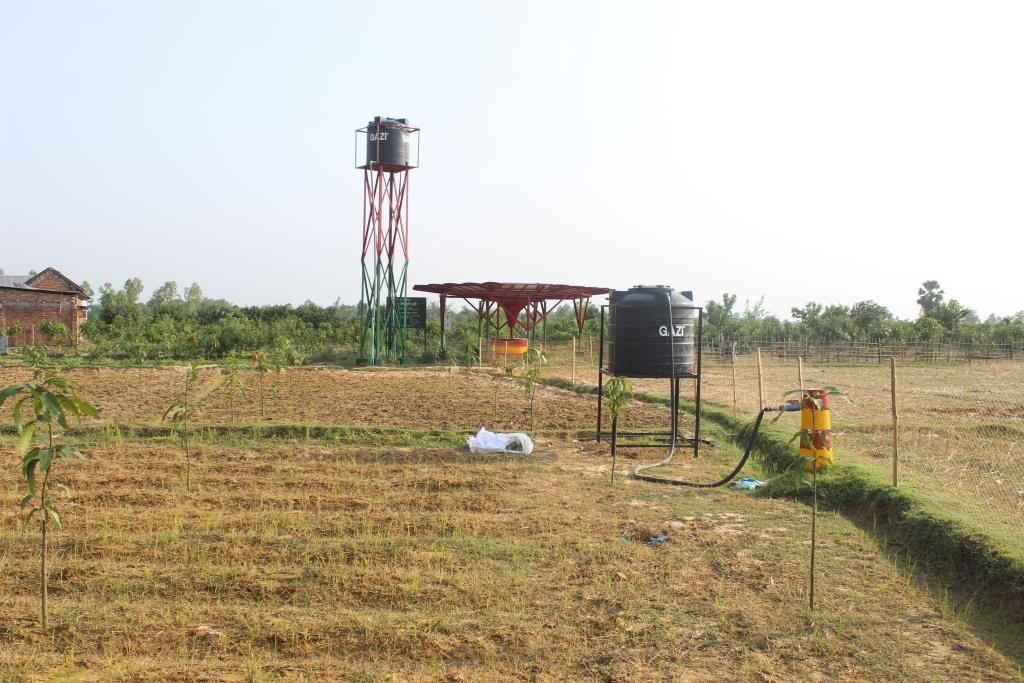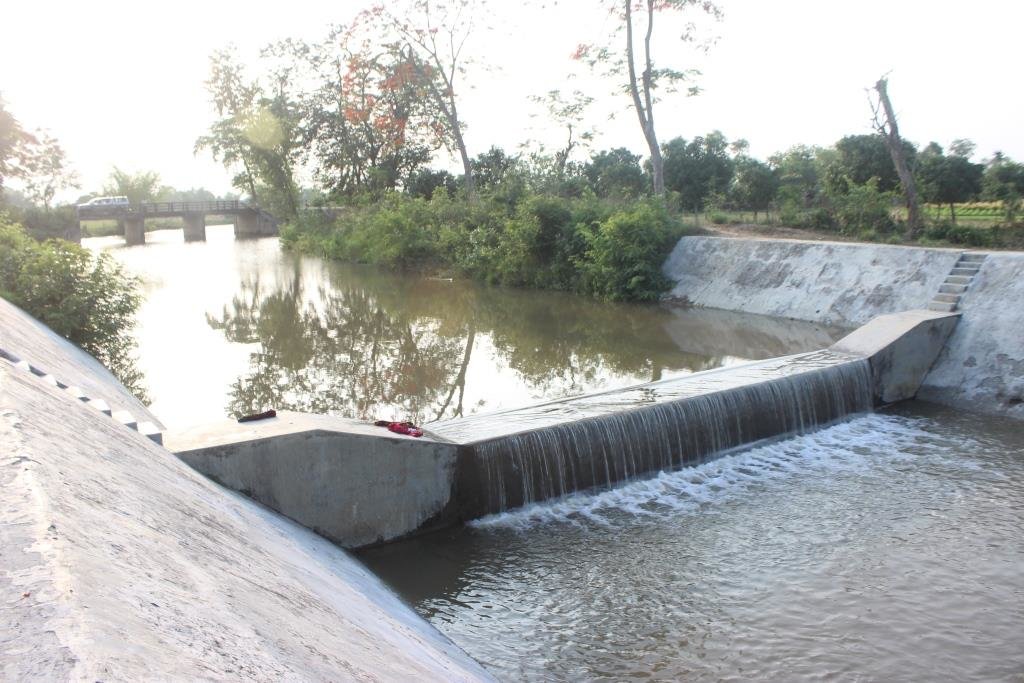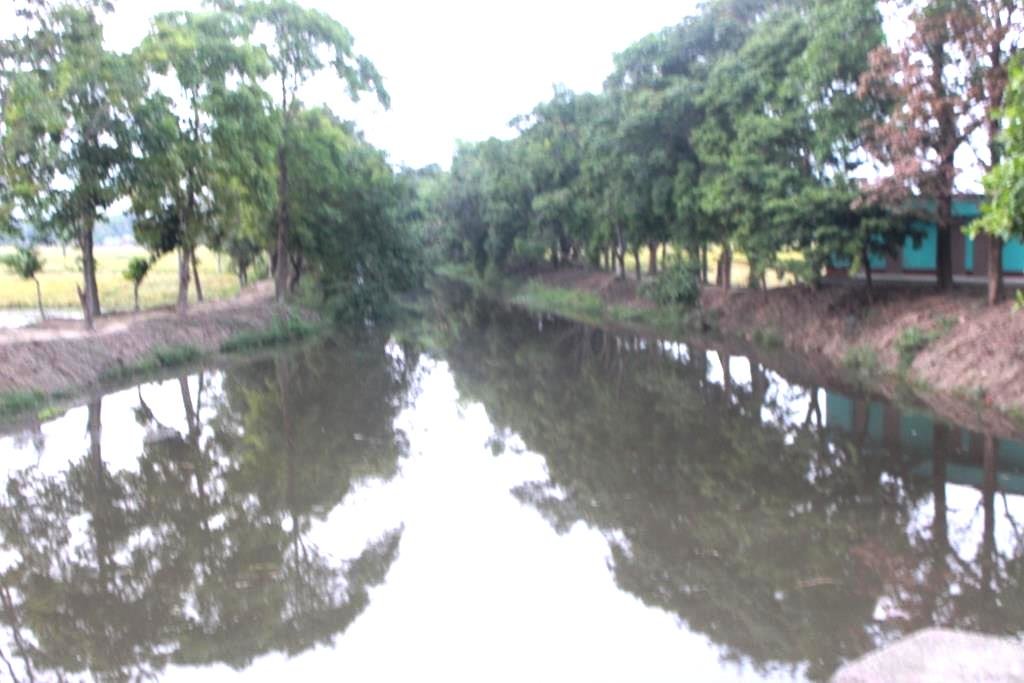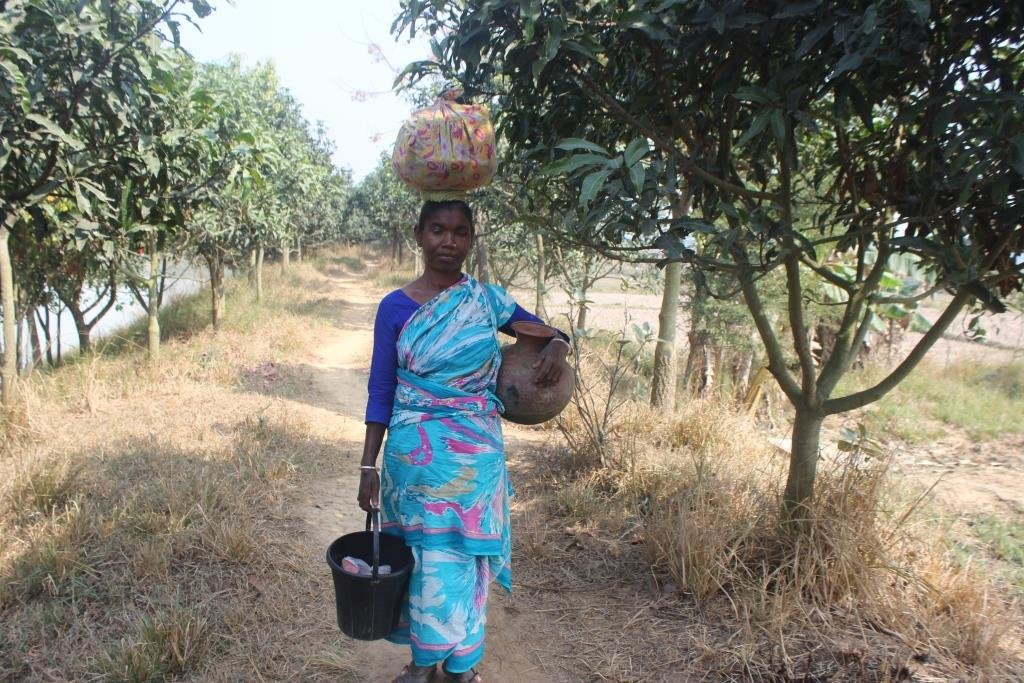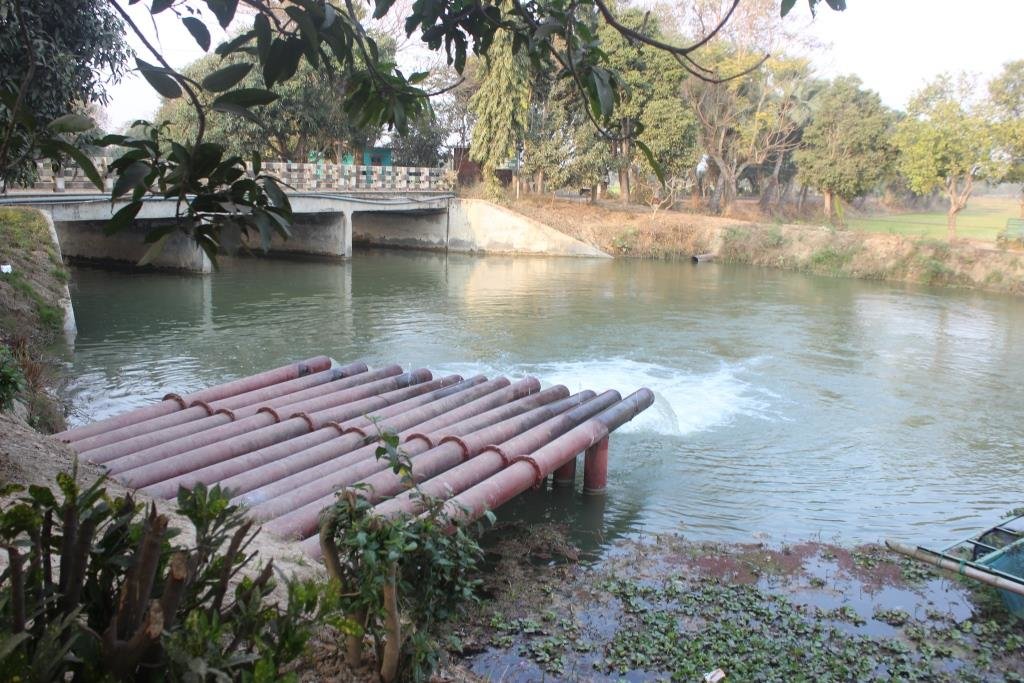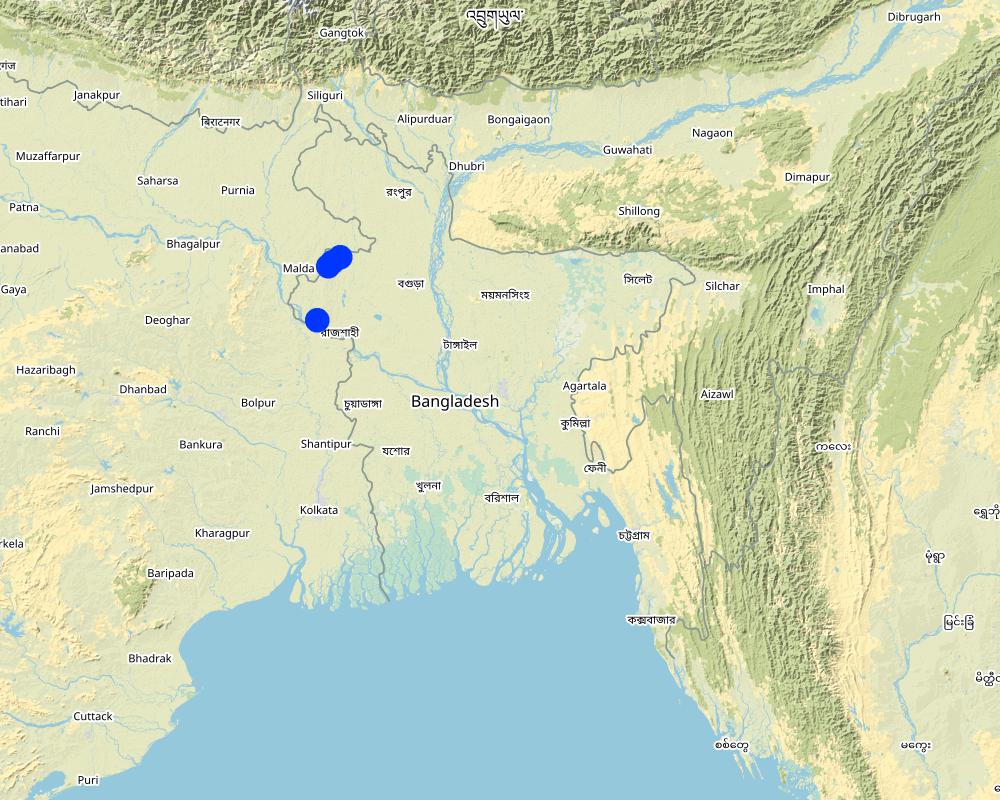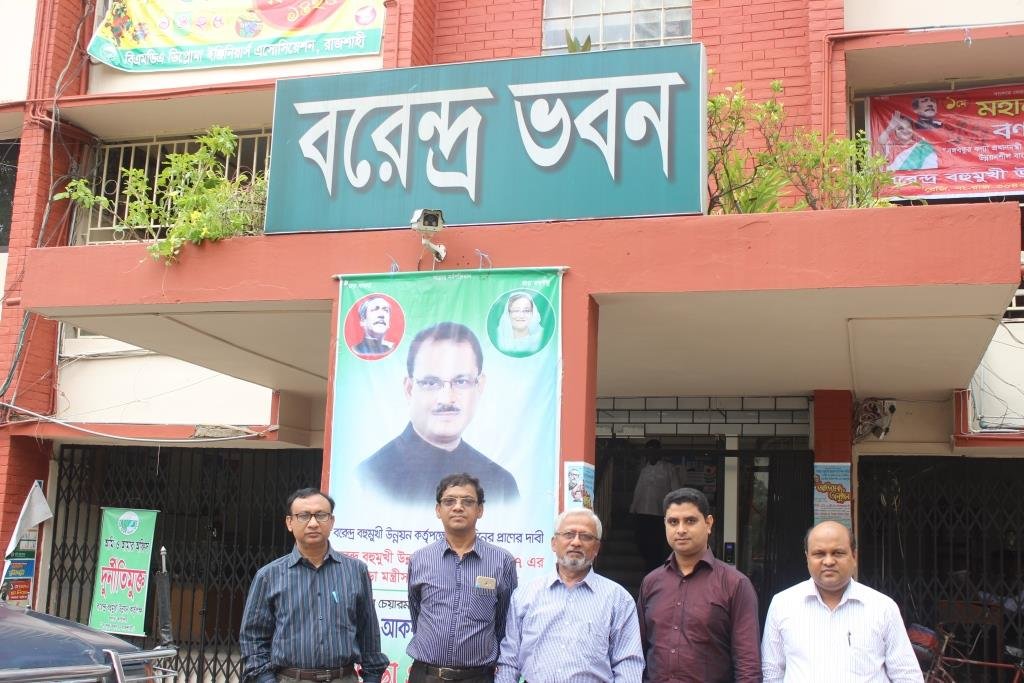Halting seasonal drought in Barind through efficient water resource management [Bangladesh]
- Création :
- Mise à jour :
- Compilateur : Jalal Uddin Md. Shoaib
- Rédacteur : –
- Examinateurs : William Critchley, Rima Mekdaschi Studer
Barendra elakay Khara proshaman
approaches_6143 - Bangladesh
Voir les sections
Développer tout Réduire tout1. Informations générales
1.2 Coordonnées des personnes-ressources et des institutions impliquées dans l'évaluation et la documentation de l'Approche
Nom du projet qui a facilité la documentation/ l'évaluation de l'Approche (si pertinent)
Establishing National Land Use and Land Degradation Profile toward Mainstreaming SLM Practices in Sector Policies (ENALULDEP/SLM)Nom du ou des institutions qui ont facilité la documentation/ l'évaluation de l'Approche (si pertinent)
Department of Environment (DoE) - Bangladesh1.3 Conditions relatives à l'utilisation par WOCAT des données documentées
Quand les données ont-elles été compilées (sur le terrain)?
08/04/2020
Le compilateur et la(les) personne(s) ressource(s) acceptent les conditions relatives à l'utilisation par WOCAT des données documentées:
Oui
2. Description de l'Approche de GDT
2.1 Courte description de l'Approche
Introduction of sustainable water usage to prevent impacts of seasonal droughts in Barind region, Bangladesh
2.2 Description détaillée de l'Approche
Description détaillée de l'Approche:
Barind is a drought-affected area of Bangladesh. It covers about 7,770 sq. km, that is 41% of the North Western part of Bangladesh, spreading over 16 districts of Rajshahi and Rangpur Division. It is one of the driest areas in Bangladesh with comparatively high temperatures - though cooler in the wet season from mid-June to October. Rainfall in the area varies from about 1500 mm to 2000 mm per annum. Temperature ranges from 4 degree Celsius to 44 degree Celsius. The area is at a comparatively higher elevation than the adjoining floodplains. There are two main terrace levels - one at 40m and the other between 19.8 and 22.9 m above mean sea level. The total cultivable area of Barind is about 583,000 ha, of which 34% is loamy, 10% is sandy, and 49% is clay: the remaining 7% is of other composition.
In the 1980s, the area was predominantly single cropped, and yields were poor and subject to seasonal drought, from late February to early May (up to the onset of pre-monsoon). No crops could be grown during the "rabi" season (November to May). The impacts of drought were severe and affected food insecurity and livelihoods. To address the situation, the Bangladesh Agricultural Development Corporation (BADC) under the Ministry of Agriculture (MoA) initiated two projects. One in 1985: The Barind Integrated Area Development Project and subsequently in 1992, the Barind Multipurpose Development Authority (BMDA) as a separate institutional entity. Both the projects focused on a new approach to water extraction, distribution and management practices at institutional level. Deep tubewells were installed and maintained by BMDA, rather than privately (which is often practiced in other parts of the country).
Deep tubewells (DTWs) were installed to abstract water from 15-20 meters, and water was initially distributed through open channels. Later, these were fitted with smart card–operated electric/solar pumps to develop a drought-resilient irrigation system Both projects have helped the Barind region reduce poverty and achieve self-sufficiency in rice. Without supplementary irrigation, there would be crop failure.
Since it was established, BMDA has focused on halting seasonal drought in Barind, and increased cropping intensity by providing irrigation through 15,800 DTWs in different districts. That reduced the cost of irrigation water for one bigha (0.1ha) from about $40 to <$20. On the other hand initiation of smart cards and buried pipelines for water distribution increased the efficiency of water use and facilitated revenue collection by the BMDA. However abstraction of groundwater (GW) for irrigation triggered another issue - drawdown of GW in the area, which even led to abandoning shallow tubewells (STW) used for drinking water.
In 2004 BMDA initiated another project, to lift surface water from the Padma river to ponds/canals/rivers in the main land after re-excavation. These sources are used as reservoirs and at the same time contribute to GW recharge generally. At the same time, usage of solar power instead of electricity is another means of reducing the cost of pumping water.
BMDA again installed 490 dugwells where STW or DTW could not be constructed. These dug wells are used for safe drinking water and small-scale irrigation. These measures have meant that, at present, the area avoids seasonal drought in most of the locations. Potatoes, "boro" and transplanted "aman" occupy more than 50% of the cultivable land. In addition, provision of safe drinking water and improved communications have boosted the local economy. The approach embraces various technologies including (1) tapping river water (from the Ganges, Mahananda and Tangan rivers0; (2) storing water in creeks or ponds; (3) distribution to farm land through subsurface irrigation pipes (buried pipelines); (4) use of low lift pumps (LLP) with solar energy support ; (5) prepaid water metering - usage of smart cards; (6) conversion of derelict water bodies to become effective water reservoirs ; (7) dug wells with solar power for water abstraction; (8) orchard plantations where both surface or groundwater are limited; (9) plantations of trees and horticultural crops along road and channels to change the land cover; (10) usage of compost to improve soil health. All of these contribute to land degradation neutrality (LDN) in one way or another.
Finally BMDA's approach is to boost productivity in the drought affected Barind through its projects, and encouraged communities to adopt diversified land use: previously much land remained fallow during most of the year outside the monsoon. Institutions like Department of Agricultural Extension (DAE) and many NGOs promote a variety of seasonal, annual and perennial crops in the area, the use of balanced fertilizer, plantation of high density fruit crops. The impact of the BMDA approach has greatly changed the drought-affected Barind.
2.3 Photos de l'approche
Remarques générales concernant les photos:
All these pictures demonstrate the usage of surface water for irrigation and livelihoods in Barind.
2.5 Pays/ région/ lieux où l'Approche a été appliquée
Pays:
Bangladesh
Région/ Etat/ Province:
Rajshahi
Commentaires:
Barind which was the driest area of Bangladesh, has now changed its landscape to green.
Map
×2.6 Dates de début et de fin de l'Approche
Indiquez l'année de démarrage:
1992
Commentaires:
Barind Multipurpose Development Authority (BMDA) is continuing with more development projects to provide irrigation facilities with more options. Cropping intensity has increased, and most of the single cropped land has been transformed to double and triple cropped land.
2.7 Type d'Approche
- fondé sur un projet/ programme
2.8 Principaux objectifs de l'Approche
To provide irrigation water for cropping in dry season.
To increase cropping intensity in drought affected areas of Barind.
To manage land use or land cover in Barind.
To mobilize community on rational usage of soil and water resources.
2.9 Conditions favorisant ou entravant la mise en œuvre de la(des) Technologie(s) appliquée(s) sous l'Approche
normes et valeurs sociales/ culturelles/ religieuses
- favorise
Increased livelihood options and access to education, marketing, health services.
disponibilité/ accès aux ressources et services financiers
- favorise
Increased access to financial institution.
cadre institutionnel
- favorise
All technical support provided by BMDA.
collaboration/ coordination des acteurs
- favorise
BMDA supports all action in related to irrigation, maintenance, water supply etc.
cadre juridique (régime foncier, droits d'utilisation des terres et de l'eau)
- favorise
Lands owned by land users
cadre politique
- favorise
Land users are in the line of BMDA policies.
gouvernance foncière (prise de décisions, mise en œuvre et application des décisions)
- favorise
Traditional approach.
connaissances sur la GDT, accès aux supports techniques
- favorise
Community has access to technical support.
marchés (pour acheter les intrants, vendre les produits) et prix
- favorise
All inputs are available in the area.
charge de travail, disponibilité de la main-d'œuvre
- favorise
Available, people are getting work now.
3. Participation et rôles des parties prenantes impliquées dans l'Approche
3.1 Parties prenantes impliquées dans l'Approche et rôles
- exploitants locaux des terres / communautés locales
Men and women are involved in the process
Growing crops as of their choice, for example: rice, fruits, vegetables or orchard trees.
- organisations communautaires
Farmers have societies,
Influenced in choice of crops, etc.
- ONG
Several NGO s are functional in the area.
Most of them are supporting credit and marketing facilities
- gouvernement local
Local institutions involved in the process
Capacity building, advisory services on fertilizer usage, crop selection etc.
Si plusieurs parties prenantes sont impliquées, indiquez l'organisme chef de file ou l'institution responsable:
BMDA is working as lead agency
3.2 Participation des exploitants locaux des terres/ communautés locales aux différentes phases de l'Approche
| Participation des exploitants locaux des terres/ communautés locales | Spécifiez qui était impliqué et décrivez les activités | |
|---|---|---|
| initiation/ motivation | passive | Farmers are using irrigation water for their crops supplied by BMDA and they pay revenue |
| planification | passive | Farmer nor the community are involved in the planning process |
| mise en œuvre | passive | Land users allow to set buried pipelines under their fields. |
| suivi/ évaluation | passive | Land users are not involved in the M&E but they participate in the events organized. |
| aucun | Land users only choose their crops to be grown |
3.3 Diagramme/ organigramme (si disponible)
Description:
Barind Multipurpose Development Authoroty (BMDA) is the symbol of development in Barind area also of the Tista fldooplain and the Old Himalayan piedmont plain.
Auteur:
ShoaibJU
3.4 Prises de décision pour la sélection de la Technologie/ des Technologies
Indiquez qui a décidé de la sélection de la Technologie/ des Technologies à mettre en œuvre:
- principalement les exploitants des terres soutenus par des spécialistes de la GDT
Spécifiez sur quelle base ont été prises les décisions:
- l'évaluation de connaissances bien documentées en matière de GDT (prises de décision fondées sur des preuves tangibles)?
- les résultats de recherches?
- expériences et opinions personnelles (non documentées)
4. Soutien technique, renforcement des capacités et gestion des connaissances
4.1 Renforcement des capacités/ formation
Une formation a-t-elle été dispensée aux exploitants des terres/ autres parties prenantes?
Oui
Spécifiez qui a été formé:
- exploitants des terres
- personnels/ conseillers de terrain
Si pertinent, spécifiez le genre, l'âge, le statut, l'ethnie, etc.
BMDA has trained staff to care for the system by and large. There are both male and female staff.
Formats de la formation:
- sur le tas
- zones de démonstration
Thèmes abordés:
Buried pipeline maitenance, good seed production, marketing etc.
4.2 Service de conseils
Les exploitants des terres ont-ils accès à un service de conseils?
Oui
Spécifiez si le service de conseils est fourni:
- dans des centres permanents
Décrivez/ commentez:
BMDA has field offices at each upazila to look after the system
4.3 Renforcement des institutions (développement organisationnel)
Des institutions ont elles été mises en place ou renforcées par le biais de l'Approche?
- oui, beaucoup
Spécifiez à quel(s) niveau(x), ces institutions ont été renforcées ou mises en place:
- local
- régional
Décrivez l'institution, ses rôles et responsabilités, ses membres, etc.
BMDA has it headquarters at Rajshai city and sub-offices at all "upazila" to where the pipeline extended.
Précisez le type de soutien:
- renforcement des capacités/ formation
- équipement
4.4 Suivi et évaluation
Le suivi et l'évaluation font ils partie de l'Approche? :
Oui
Commentaires:
BMDA monitors groundwater levels regularly, and also the pipelines and other operational activities.
Si oui, ce document est-il destiné à être utilisé pour le suivi et l'évaluation?
Oui
Commentaires:
During the documentation of the SLM best practices of the Banrind area intensive conversations, meetings and workshops were organized with all officials of headquarter and filed offices.
4.5 Recherche
La recherche a-t-elle fait partie intégrante de l’Approche?
Non
5. Financement et soutien matériel externe
5.1 Budget annuel de la composante GDT de l'Approche
Si le budget annuel précis n'est pas connu, indiquez une fourchette:
- 10 000-100 000
5.2 Soutiens financiers/ matériels fournis aux exploitants des terres
Les exploitants des terres ont-ils reçu un soutien financier/ matériel pour la mise en œuvre de la Technologie/ des Technologies?
Oui
Si oui, spécifiez le(s) type(s) de soutien, les conditions et les fournisseurs:
All infrastructural establishment cost were born by BMDA
5.3 Subventions pour des intrants spécifiques (incluant la main d'œuvre)
- aucun
- équipement
| Spécifiez les intrants subventionnés | Dans quelle mesure | Spécifiez les subventions |
|---|---|---|
| pierres | entièrement financé | |
- matériaux de construction
| Spécifiez les intrants subventionnés | Dans quelle mesure | Spécifiez les subventions |
|---|---|---|
| routes | entièrement financé | |
- infrastructures
| Spécifiez les intrants subventionnés | Dans quelle mesure | Spécifiez les subventions |
|---|
5.4 Crédits
Des crédits ont-ils été alloués à travers l'Approche pour les activités de GDT?
Non
5.5 Autres incitations ou instruments
D'autres incitations ou instruments ont-ils été utilisés pour promouvoir la mise en œuvre des Technologies de GDT?
Oui
Si oui, spécifiez:
Installation and maintenance cost borne by BMDA, but farmers have to pay for water through smart cards (Pre-paid).
6. Analyses d'impact et conclusions
6.1 Impacts de l'Approche
Est-ce que l'Approche a autonomisé les exploitants locaux des terres, amélioré la participation des parties prenantes?
- Non
- Oui, un peu
- Oui, modérément
- Oui, beaucoup
Farmers are using irrigation water for their crops
Est-ce que l'Approche a permis la prise de décisions fondées sur des données probantes?
- Non
- Oui, un peu
- Oui, modérément
- Oui, beaucoup
As of now buried pipe lines for irrigation water supply are being adopting in many areas of the country.
Est-ce que l'Approche a aidé les exploitants des terres à mettre en œuvre et entretenir les Technologies de GDT?
- Non
- Oui, un peu
- Oui, modérément
- Oui, beaucoup
Usage of water rationally: BMDA installs control meters for each of the land user.
Est-ce que l'Approche a amélioré la coordination et la mise en œuvre de la GDT selon un bon rapport coût-efficacité?
- Non
- Oui, un peu
- Oui, modérément
- Oui, beaucoup
The approach had changed the Barind ecosystem at large.
Est-ce que l'Approche a amélioré les connaissances et les capacités des exploitants des terres pour mettre en œuvre la GDT?
- Non
- Oui, un peu
- Oui, modérément
- Oui, beaucoup
Land users enable to use irrigation water for growing crops of their choice
Est-ce que l'Approche a amélioré les connaissances et les capacités des autres parties prenantes?
- Non
- Oui, un peu
- Oui, modérément
- Oui, beaucoup
Other local institutions in Barind area are involved in the system.
Est-ce que l'Approche a construit/ renforcé les institutions, la collaboration entre parties prenantes?
- Non
- Oui, un peu
- Oui, modérément
- Oui, beaucoup
Adoption of the irrigation system at all areas of the Barind.
Est-ce que l'Approche a atténué les conflits?
- Non
- Oui, un peu
- Oui, modérément
- Oui, beaucoup
Stakeholders are enable to use water as they like.
Est-ce que l'Approche a autonomisé les groupes socialement et économiquement défavorisés?
- Non
- Oui, un peu
- Oui, modérément
- Oui, beaucoup
The area was resource poor before the 1990s. Now livelihoods of the community improved largely.
Est-ce que l'Approche a amélioré l'égalité entre hommes et femmes et autonomisé les femmes et les filles?
- Non
- Oui, un peu
- Oui, modérément
- Oui, beaucoup
Man and women are engaged themselves in their land and crops.
Est-ce que l'Approche a encouragé les jeunes/ la prochaine génération d'exploitants des terres à s'engager dans la GDT?
- Non
- Oui, un peu
- Oui, modérément
- Oui, beaucoup
Interventions with new crops, specially high value fruits etc in the area.
Est-ce que l'Approche a amélioré les questions foncières et des droits d'utilisation qui entravent la mise en œuvre des Technologies?
- Non
- Oui, un peu
- Oui, modérément
- Oui, beaucoup
Land tenure system is traditional, where large areas are sublet or leased to the individuals or groups by the land owners.
Est-ce que l'Approche a conduit à améliorer la sécurité alimentaire et/ou la nutrition?
- Non
- Oui, un peu
- Oui, modérément
- Oui, beaucoup
The area produces a large amount of cereals, potatoes, vegetables, fruits etc.
Est-ce que l'Approche a amélioré l'accès aux marchés?
- Non
- Oui, un peu
- Oui, modérément
- Oui, beaucoup
Fruits and paddy rice have good markets.
Est-ce que l'Approche a conduit à améliorer l'accès à l'eau et l'assainissement?
- Non
- Oui, un peu
- Oui, modérément
- Oui, beaucoup
Safe drinking water where tubewells do not function, and sanitation also developed as the system.
Est-ce que l'Approche a conduit à l'utilisation/ sources d'énergie plus durables?
- Non
- Oui, un peu
- Oui, modérément
- Oui, beaucoup
Using solar power to abstract dug well water greatly facilitates the community.
Est-ce que l'Approche a amélioré la capacité des exploitants des terres à s'adapter aux changements/ extrêmes climatiques et a atténué les catastrophes liées au climat?
- Non
- Oui, un peu
- Oui, modérément
- Oui, beaucoup
Vegetative cover in the Barind has changed the ecosystem at large.
Est-ce que l'Approche a conduit à des emplois, des opportunités de revenus?
- Non
- Oui, un peu
- Oui, modérément
- Oui, beaucoup
Local people are having work everywhere of the Barind.
6.2 Principale motivation des exploitants des terres pour mettre en œuvre la GDT
- augmenter la production
Cropping intensity increased
- augmenter la rentabilité/ bénéfice, rapport coûts-bénéfices
Low cost of irrigation water contributes to benefits for the land users.
- réduire la dégradation des terres
Halts or reduces seasonal drought
- réduire les risques de catastrophe
Less climate extremes, no crop loss due to drought. Temperature relatively cooler than before.
- règles et règlements (amendes)/ application
No social unrest
- prestige, pression sociale/ cohésion sociale
Livehood improved greatly.
- conscience environnementale
Local people are now aware of the environment. They grow trees around their homesteads, preserve water in their ponds etc.
6.3 Durabilité des activités de l'Approche
Les exploitants des terres peuvent-ils poursuivre ce qui a été mis en œuvre par le biais de l'Approche (sans soutien extérieur)?
- oui
Si oui, décrivez de quelle manière:
Buried pipeline irrigation has changed the Barind area greatly.
6.4 Points forts/ avantages de l'Approche
| Points forts/ avantages/ possibilités du point de vue de l'exploitant des terres |
|---|
| More crops could be grown throughout the year, |
| Crop diversity is possible, annual, perenial or seasonal |
| Secure crop production |
| Points forts/ avantages/ possibilités du point de vue du compilateur ou d'une autre personne ressource clé |
|---|
| Minimum loss of irrigation water |
| Surface (river) water usage minimize stress on ground water usage |
| Improved ground water recharge |
| Safe drinking water where tubewell is not available. |
| Usage of solar power for lifting water from dug well or for lifting water to buried pipeline |
| Introduction of water meters reduces misuse of irrigation water |
6.5 Faiblesses/ inconvénients de l'Approche et moyens de les surmonter
| Faiblesses/ inconvénients/ risques du point de vue de l’exploitant des terres | Comment peuvent-ils être surmontés? |
|---|---|
| The system could be implemented at single farmer level | Developing community approach with the support of the government |
| Faiblesses/ inconvénients/ risques du point de vue du compilateur ou d'une autre personne ressource clé | Comment peuvent-ils être surmontés? |
|---|---|
| Very high pressure on land and soil resources | Lower water consumptive crops could be introduced |
| Severe soil nutrient depletion may develop | Use of manure/ compost or organic matter or crop rotation to enrich soil |
7. Références et liens
7.1 Méthodes/ sources d'information
- visites de terrain, enquêtes sur le terrain
Intensive field visit with responsible officers (5) from BMDA and interview with beneficiaries (30) .
- interviews/entretiens avec les exploitants des terres
Especially the farmers (5) who used to grow very high density fruits crops and of solar powered dugwell (3)
- interviews/ entretiens avec les spécialistes/ experts de GDT
10 officers from different institutions, like BMDA, DAE, University of Rajshahi, SRDI, NGO, Fishries etc.
- compilation à partir de rapports et d'autres documents existants
Few official docments of design and plan of pipelines, dugwell etc.
7.3 Liens vers les informations pertinentes disponibles en ligne
Titre/ description:
Baring Multipupose Development Authority
URL:
http://www.bmda.gov.bd/site/page/2ea693ba-ac10-4ada-b304-111d72a72105/-#
Titre/ description:
Pro-Poor Groundwater Development
URL:
https://openknowledge.worldbank.org/bitstream/handle/10986/33246/Pro-Poor-Groundwater-Development-The-Case-of-the-Barind-Experiment-in-Bangladesh.pdf?sequence=5
Liens et modules
Développer tout Réduire toutLiens
Aucun lien
Modules
Aucun module trouvé





